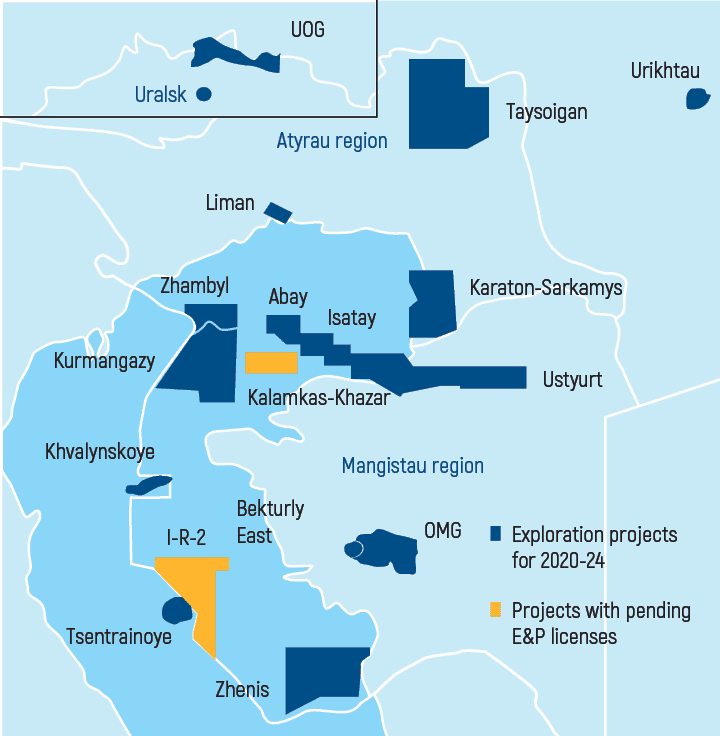Exploration

Strategic objectives in ensuring growth in reserves
| Organic growth | Inorganic growth |
|---|---|
|
|
KMG’s portfolio consists primarily of mature fields, which prioritises exploration as part of the long-term strategy to maintain stable production levels. This requires a focus on execution and operational excellence, the search for resource replenishment solutions and unlocking new reserves and bringing them online both at new and mature fields, based on the results of further exploration activities.
Additions to oil reserves are expected to be driven through both organic and inorganic growth. Growth in KMG’s reserves will rely on the implementation of exploration projects onshore and within the Kazakhstan sector of the Caspian Sea, and going forward, with further exploration in licenses operated by our subsidiaries. In 2019, KMG’s portfolio comprised 16 exploration projects, of which 8 were offshore and 8 onshore.
KMG is conducting comprehensive studies of Kazakhstan’s sedimentary basins to assess their oil and gas potential and build a portfolio of promising blocks for subsoil use. In 2019, we completed the models of the Ustyurt-Bozashin sedimentary basin’s petroleum system and the Pre-Caspian sedimentary basin flanks (North, East and South), along with the tectonic-sedimentary model of the South Turgay sedimentary basin.
A portfolio of five new promising subsoil use projects was built, including 15 projects for inclusion in the National Acreage Management Programme and five projects for state geological surveys in accordance with Kazakhstan’s Subsoil and Subsoil Use Code.
In addition, the Company carried out extensive seismic field surveys over promising areas within the Pre-Caspian, Mangyshlak and South Turgay sedimentary basins, and over offshore areas of the Caspian Sea. One of the year’s highlights was the completion of seismic field surveys over the Taisoigan area, acquiring a total of 5,600 sq. km of data, the largest high-resolution seismic survey project in the modern history of our nation.
Exploration drilling programmes were also completed in the Urikhtau and Bekturly East areas, which resulted in the identification of the Jurassic, Triassic and Permian-Carboniferous oil and gas prospects. Test programmes have been scheduled for 2020.
Exploration costs totalled KZT 53 bln (excluding shares) in 2019.
| Exploration | 2017 | 2018 | 2019 |
|---|---|---|---|
| 2D seismic, linear km | - | 1,000 | 240 |
| 3D seismic, sq. km. | 4,299 | 1,253 | 6,928 |
| Number of wells drilled | 50 | 54 | 39 |

Expansion of partnership projects
During the year KMG continued to expand its cooperation in exploration with international oil and gas companies:
- On 11 February 2019, to facilitate participation in drilling projects within the Azerbaijan sector of the Caspian Sea, we gave the go-ahead for a KZT 21.6 bln (USD 57 mln) capex project to upgrade our jack-up drilling rig. To implement the project, KMG Drilling&Services and Caspian Drilling Company signed a trusteeship agreement to transfer the Satti jack-up drilling rig to Caspian Drilling Company for modification and further operation on subsoil use projects within the Azerbaijan sector of the Caspian Sea. The rig modification project is currently in progress, with the trustee currently in talks with BP Azerbaijan on the terms of a drilling contract to use the Satti rig at the Shallow Water Absheron Peninsula project.
- On 17 May 2019, KMG and British Petroleum (BP) signed a memorandum of understanding to jointly review the available technical data and existing assets of KMG and third parties.
- On 20 September 2019, KMG and LUKOIL signed an agreement on the joint study of areas within the territory of the Republic of Kazakhstan.
- On 24 September 2019, KMG and Equinor signed a joint study agreement providing for geological and geophysical studies to assess the hydrocarbon potential of oil and gas areas in Kazakhstan.

Given the recent amendments to the national tax and subsoil use laws aimed at stimulating new exploration, in 2019 KMG focused on attracting strategic partners to new subsoil use projects.
- On 1 April 2019, the Ministry of Energy of the Republic of Kazakhstan, KMG and PJSC LUKOIL (LUKOIL) signed a contract for the exploration and production of hydrocarbons at the Zhenis block, located in the Kazakhstan sector of the Caspian Sea. According to a joint estimate by KMG and LUKOIL, the block’s projected recoverable resources (C3) are 65.1 mln tonnes. The project operator is Zhenis Operating LLP (a 50/50 joint venture between KMG and LUKOIL).
- On 7 June 2019, KMG and LUKOIL signed the heads of agreement for the I-P-2 project covering the block of the same name located in the Kazakhstan sector of the Caspian Sea. According to a preliminary estimate by LUKOIL, the block’s projected recoverable resources (C1) are 15.1 mln tonnes. Both companies plan to sign a contract with Kazakhstan’s Energy Ministry for the exploration and production of hydrocarbons at the 1-P-2 block in 2020.
- On 26 July 2019, the Ministry of Energy of the Republic of Kazakhstan, KMG and Eni S.p.A. (Eni) signed a contract for hydrocarbon exploration at the Abay block, located in the Kazakhstan sector of the Caspian Sea. The project operator is Isatai Operating Company LLP (a 50/50 joint venture between KMG and Eni).